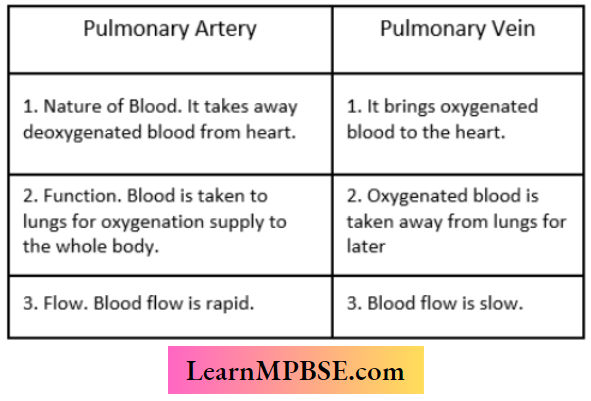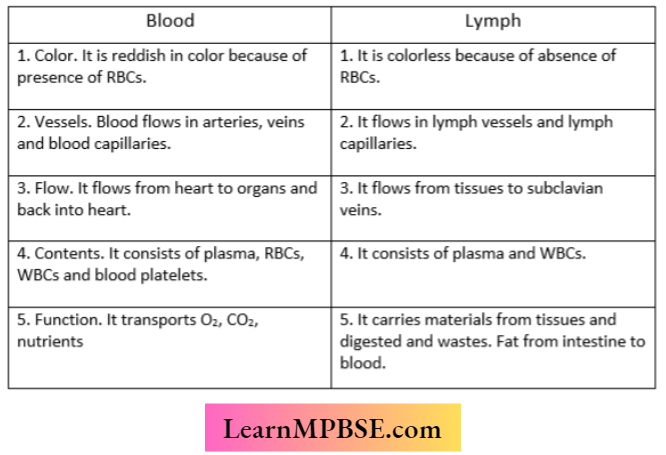MPBSE Class 10 Science Life Processes Question and Answers
Question 1. (1) How many times does the blood go through the heart during one cycle in fish and why?
{2) List the respiratory pigment present in our body. Where is it present?
(3) Why are valves present in the heart and veins?
Answer:
- Fish have a single circulation of blood in contrast to double circulation in humans. In fish, the heart pumps the blood into the gills for purification. From the gills, the purified blood goes to the body and then comes back to the heart for pumping.
- Haemoglobin is the respiratory pigment. It is present in the red blood corpuscles.
- Valves are present in the heart and veins to prevent the backflow of blood.
Question 2. (1) Explain in brief the mechanism of circulation of blood in the human body.
(2) “Lymph is another type of fluid involved in transportation.” Justify the statement by explaining the process.
Answer:
(1) The right atrium receives deoxygenated blood from the heart (coronary sinus), upper part of the body (superior vena cava), and middle and lower part of the body (inferior vena cava). The left atrium receives oxygenated blood from the lungs.
- As the two atria get filled, they contract simultaneously and pour their blood into the ventricles of their side through auriculo-ventricular apertures.
- On getting filled, the ventricles undergo systole. The left ventricle sends oxygenated blood to all body parts through the systemic aorta. The right ventricle sends deoxygenated blood to the lungs through the pulmonary arch for oxygenation.
(2) Lymph is a transportation fluid formed from tissue fluid. It is specialised to collect large size secretions and excretions which cannot directly pass into the blood, For Example., proteins, hormones, and fat. The lymph picks them and pours their contents into the blood in the region of the subclavian vein.
Life Processes Class 10 Questions And Answers
Question 3. (1)(A) Receives deoxygenated blood from vena cava (B) Sends deoxygenated blood to the lung through the pulmonary artery (C) Receives oxygenated blood from lungs and (D) Sends oxygenated blood to all parts of the body through the aorta.
(2) What does the blood consist of?
(3) Name the respiratory pigment in human beings and discuss its role.
Answer:
- (A) Right atrium (B) Right ventricle (C) Left atrium (D) Left ventricle.
- Blood consists of blood plasma (55%) and blood cells (45%) of three types red blood corpuscles, white blood corpuscles and blood platelets.
- Haemoglobin is the respiratory pigment that is found in red blood corpuscles. It carries oxygen as oxyhaemoglobin and a part of carbon dioxide as carbaminohaemoglobin.
Question 4. What is lymph? How is the composition of lymph different from blood plasma? What is the direction of its flow? List two functions of the lymphatic system.
Answer:
Lymph is a straw-coloured viscous fluid which is formed from tissue fluid and flows inside tubes called lymph vessels.
Lymph differs from blood plasma in having :
- 94% water instead of 92% in plasma
- 3.0 to 4.5 per cent protein instead of 6-8% protein in blood plasma
- Globulin and fibrinogen contents are lower
- Lymph receives a direct supply of secretion and excretion of tissues while blood obtains the same from lymph.
Direction of Flow. Unidirectional from tissues all over the body to subclavian veins.
Functions of Lymphatic System.
- The lymphatic system functions as a middleman between tissue fluid and blood,
- It picks up germs and takes them to lymph nodes for disposal.
Question 5. (A) What do the following transport: (1) Xylem (2) Phloem (3) Pulmonary vein (4) Vena Cava?
(B) Write two points of difference between the pulmonary artery and the pulmonary vein.
Answer:
- (A) Xylem. Transports sap (water and mineral salts) from roots to aerial parts of the plant.
- Phloem. It translocates food and other solutes from a place of manufacture or storage to a place of utilisation both in upward and downward directions.
- Pulmonary Vein. It carries oxygenated blood from the lungs to the left auricle.
- Vena Cava. It carries deoxygenated blood from different parts of the body to the right auricle. Differences between Pulmonary Artery and Pulmonary Vein

Mpbse Class 10 Science Chapter 6 Solutions
Question 6. (1) The upward movement of water normally requires a pump in our houses but in tall trees, water rises up without any external support. Explain the mechanism.
(2) State three points of difference between the transport of materials in the xylem and phloem.
Answer:
(1) Water rises up the top of the tallest plants through the development of a negative pressure caused by loss of water in transpiration. Transpiration or loss of water in vapour form occurs from mesophyll and other cells of aerial parts.
- As there are innumerable numbers of cells losing water, they develop a tremendous suction pressure and withdraw water from the nearby xylem channels. This puts the water present in the xylem channel under a negative pressure of 10-20 atm.
- Negative pressure or pull caused by transpiration is unable to break the continuity of the water column due to the presence of cohesion force amongst water molecules and adhesion force between water and the wall of the xylem channel.
- The negative pressure or transpiration pull reaches the root region and forces water to move upwards. It is just like upward pulling of a cold drink with the help of a straw pipe. The mechanism of the ascent of sap through transpiration pull and cohesion force was given by Dixon and Jolly (1894).

2. Force. It comes from the development of negative press- 2. It develops from the formation of turgor pressure, sure or transpiration pull.
3. Channel. The conducting channels are made of the conducting channels are formed of living sieves dead lignified elements, vessels and tracheids. tube elements.
Question 7. (1) Mention any two components of blood.
(2) Trace the movement of oxygenated blood in the body.
(3) Write the function of valves present in between atria and ventricles.
(4) Write one structural difference between artery and vein.
Answer:
- Composition of Blood. Blood cells—45%. Plasma—55%. Blood cells arc of three types—red blood corpuscles, white blood corpuscles and blood platelets.
- Movement of Oxygenated Blood. Blood is oxygenated in the lungs. Pulmonary veins carry the oxygenated blood from the lungs to the left atrium. The left atrium pours the oxygenated blood into the left ventricle. On contraction left ventricle pushes the oxygenated blood into the aorta for supply to various parts of the body.
- Function of Valves. A tricuspid valve lies over the right atrioventricular aperture. A bicuspid valve occurs over the left atrioventricular aperture. They are meant to prevent the backflow of blood into the atria when the ventricles contract.
- Artery’ and Vein. An artery has a thicker elastic well and a narrower lumen while the vein has a thinner nonelastic wall with wider lumen and semilunar valves for preventing backflow of blood.
Important Questions Of Life Processes Class 10
Question 8. (1) Write two water-conducting elements present in plants. How does water enter continuously into the root system?
(2) Explain why plants have low energy needs as compared to animals.
Answer:
- The two water-conducting elements of plants are tracheids and vessels. Continuous Entry of Water.
- Plants have low energy requirements.
Question 9. List in tabular form three differences between blood and lymph.
Answer:

Question 10. “Blood circulation in fishes is different from the blood circulation in human beings.” Justify the statement.
Answer:
Fishes have two-chambered venous hearts with a single circulation. Human beings have four-chambered arterio¬venous hearts with double circulation.
Question 11. (1) Write the correct sequence of steps followed during the journey of oxygen-rich blood from the lungs to various organs of the human body.
(2) What happens when the system of blood vessels develops a leak?
Answer:
1. Lungs → Pulmonary veins → Left atrium → Left atrial diastole followed by contraction → Left ventricle → Left ventricle diastole followed by contraction → Aorta → Various parts of body except lungs.
2. (A) Leakage will reduce blood quantity, blood pressure mid-efficiency of a pumping system,
(B) Blood coagulation at the site of length will plug the leakage
Life Processes Class 10 Mcq
Question 13. Give Reasons
- Ventricles have thicker muscular walls than atria
- The transport system in plants is slow
- The circulation of blood in aquatic vertebrates differs from that in terrestrial vertebrates.
- During the daytime, water and minerals travel faster through the xylem as compared to the night.
- Veins have valves whereas arteries do not.
Answer:
- Thicker Walls of Ventricles.
- Slow Transport in Plants. Plants have a lower requirement of energy.
- In aquatic vertebrates, like lush there is a single blood circulation while in terrestrial vertebrates there is double circulation.
- The rate of water and mineral movement is higher during the daytime due to very high transpiration.
- There is no forceful movement of blood in the veins. Veins possess valves to prevent backflow.
